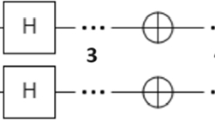Abstract
Optimization is a collection of principles that are used for problem solving in a vast spectrum of disciplines. Given the specifics of a problem and a set of constraints, the objective is to find a collection of variables that minimize or maximize an objective function. We developed a novel quantum optimization algorithm based on discrete-time quantum walks that evolve under the effect of external potentials. Each discrete lattice site corresponds to a value of the objective function’s domain of definition. The objective function is expressed as the external potential that affects the quantum walks evolution. The quantum walker is able to find the global minimum by utilizing quantum superposition of the potential affected lattice sites where the evolution occurs. We tested its performance considering two use cases. First, we designed a neural network for binary classification, where we utilized the quantum walk-based optimizer to update the neurons’ weights. We compared the results with the ones of a classical optimizer, i.e., stochastic gradient descent, on four different datasets. The quantum walks-based optimization algorithm showed the ability to match the performance of the classical counterpart using less training steps, and in some cases, it was able to find near optimal weights in only one training iteration. Finally, we considered the case of hyperparameter fine-tuning where, the quantum walk-based optimizer was used to optimize the parameters of a classical machine learning model, to increase its accuracy.






Similar content being viewed by others
Data availability
All data generated or analyzed during this study are included in the article.
References
Lloyd, S., Mohseni, M. & Rebentrost, P.: Quantum algorithms for supervised and unsupervised machine learning. Preprint at http://arxiv.org/abs/1307.0411 (2013)
Schuld, M., Petruccione, F.: Supervised Learning with Quantum Computers. Springer (2018)
Mitarai, K., Negoro, M., Kitagawa, M., Fujii, K.: Quantum circuit learning. Phys. Rev. A 98, 032309 (2018)
Li, Y., Tian, M., Liu, G., Peng, C., Jiao, L.: Quantum optimization and quantum learning: a survey. IEEE Access 8, 23568–23593 (2020)
Dunjko, V. & Briegel, H.J.: Machine learning & artificial intelligence in the quantum domain. Preprint at http://arxiv.org/abs/1709.02779 (2017)
Biamonte, J., et al.: Quantum machine learning. Nature 549, 195–202 (2017)
Havlicek, V., et al.: Supervised learning with quantum enhanced feature spaces. Nature 567, 209–212 (2019)
Park, D.K., Blank, C., Petruccione, F.: The theory of the quantum kernel-based binary classifier. Phys. Lett. A 384, 126422 (2020)
Jäger, J., Krems, R.V.: Universal expressiveness of variational quantum classifiers and quantum kernels for support vector machines. Nat. Commun. 14, 576 (2023)
Farhi, E., Neven, H.: Classification with Quantum Neural Networks on Near Term Processors. Preprint at https://arxiv.org/abs/1802.06002 (2018)
Wan, K.H., Dahlsten, O., Kristjánsson, H., Gardner, R., Kim, M.S.: Quantum generalisation of feedforward neural networks. npj Quantum Inf 3, 36 (2017)
Kingma, D.P., Ba, J.: Adam: A Method for Stochastic Optimization. Preprint at http://arxiv.org/abs/1412.6980 (2017)
Powell, M.J.D.: A direct search optimization method that models the objective and constraint functions by linear interpolation. In: Gomez, S., Hennart, J.-P. (eds.) Advances in Optimization and Numerical Analysis, pp. 51–67. Springer (1994)
Finnila, A.B., Gomez, M.A., Sebenik, C., Stenson, C., Doll, J.D.: Quantum Annealing: A New Method for Minimizing Multidimensional Functions. Preprint at https://arxiv.org/abs/chem-ph/9404003 (1994)
Kadowaki, T., Nishimori, H.: Quantum Annealing in the Transverse Ising Model. Preprint at https://arxiv.org/abs/cond-mat/9804280 (1998)
Gilliam, A., Woerner, S., Gonciulea, C.: Grover adaptive search for constrained polynomial binary optimization. Quantum 5, 428 (2021)
Varsamis, G.D., Karafyllidis, I.G.: Computing the lowest eigenstate of tight-binding Hamiltonians using quantum walks. Int. J. Quantum Inform. 20, 2250012 (2022)
Varsamis, G.D., Karafyllidis, I.G., Sirakoulis, GCh.: Hitting times of quantum and classical random walks in potential spaces. Physica A 606, 128119 (2022)
Varsamis, G.D., Karafyllidis, I.G., Sirakoulis, GCh.: Quantum walks in spaces with applied potentials. Eur. Phys. J. Plus 138, 312 (2023)
Childs, A.M.: Universal computation by quantum walk. Phys. Rev. Lett. 102, 180501 (2009)
Singh, S., Chawla, P., Sarkar, A., Chandrashekar, C.M.: Universal quantum computing using single-particle discrete-time quantum walk. Sci. Rep. 11, 11551 (2021)
Lovett, N.B., Cooper, S., Everitt, M., Trevers, M., Kendon, V.: Universal quantum computation using the discrete-time quantum walk. Phys. Rev. A 81, 042330 (2010)
Manouchehri, K., Wang, J.: Physical Implementation of Quantum Walks. Springer, Berlin (2014)
Costa, P.C.S., Portugal, R., de Melo, F.: Quantum walks via quantum cellular automata. Quantum Inf. Process. 17, 226 (2018)
Karafyllidis, I.G.: Definition and evolution of quantum cellular automata with two qubits per cell. Phys. Rev. A 70, 044301 (2004)
Huerta Alderete, C., et al.: Quantum walks and Dirac cellular automata on a programmable trapped-ion quantum computer. Nat. Commun. 11, 3720 (2020)
Loke, T., Wang, J.B.: Efficient circuit implementation of quantum walks on non-degree-regular graphs. Phys. Rev. A 86, 042338 (2012)
Douglas, B.L., Wang, J.B.: Efficient quantum circuit implementation of quantum walks. Phys. Rev. A 79, 052335 (2009)
Acasiete, F., Agostini, F.P., Moqadam, J.K., Portugal, R.: Implementation of quantum walks on IBM quantum computers. Quantum Inf. Process. 19, 426 (2020)
Liu, Y., Su, W.J., Li, T.: On quantum speedups for nonconvex optimization via quantum tunneling walks. Quantum 7, 1030 (2023)
Scikit-learn: machine learning in Python—Scikit-learn 1.2.2 documentation. https://scikit-learn.org/stable
Chui, C.K., Li, X.: Approximation by ridge functions and neural networks with one hidden layer. J. Approx. Theory 70, 131–141 (1992)
Ruder, S.: An overview of gradient descent optimization algorithms. Preprint at https://arxiv.org/abs/1609.04747 (2016)
EY Open Science Data Challenge 2023 https://challenge.ey.com/
Author information
Authors and Affiliations
Corresponding author
Ethics declarations
Conflict of interest
The authors declare that they have no conflict of interest.
Additional information
Publisher's Note
Springer Nature remains neutral with regard to jurisdictional claims in published maps and institutional affiliations.
Rights and permissions
Springer Nature or its licensor (e.g. a society or other partner) holds exclusive rights to this article under a publishing agreement with the author(s) or other rightsholder(s); author self-archiving of the accepted manuscript version of this article is solely governed by the terms of such publishing agreement and applicable law.
About this article
Cite this article
Liliopoulos, I., Varsamis, G.D. & Karafyllidis, I.G. Discrete-time quantum walk-based optimization algorithm. Quantum Inf Process 23, 23 (2024). https://doi.org/10.1007/s11128-023-04234-4
Received:
Accepted:
Published:
DOI: https://doi.org/10.1007/s11128-023-04234-4




